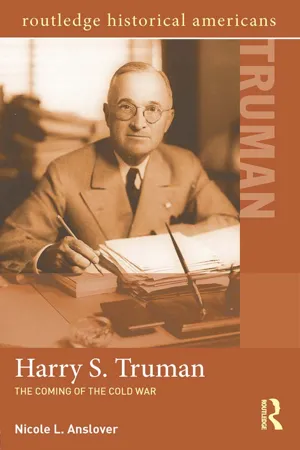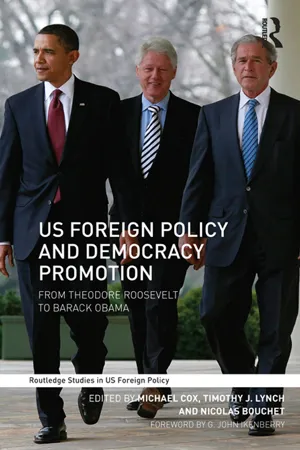History
Truman Administration
The Truman Administration refers to the presidency of Harry S. Truman, who served as the 33rd President of the United States from 1945 to 1953. This period was marked by significant events such as the end of World War II, the beginning of the Cold War, the establishment of the United Nations, and the implementation of the Marshall Plan to aid post-war recovery in Europe.
Written by Perlego with AI-assistance
Related key terms
4 Key excerpts on "Truman Administration"
- eBook - ePub
Harry S. Truman
The Coming of the Cold War
- Nicole L. Anslover(Author)
- 2013(Publication Date)
- Routledge(Publisher)
Under Truman's leadership, the foreign policy of the United States underwent a dramatic transformation between 1945 and 1953. The isolationist bent of the 1920s and 1930s was no longer a realistic option. As one of two superpowers emerging from World War II, the world expected the United States to take a stronger role in international affairs. These changes were not necessarily because of Truman's own ambitions. He did not enter office with a grand plan to increase American power abroad or to alter fundamentally foreign policy. Indeed, throughout his presidency, Truman made his foreign-policy decisions based on changing world events. He reacted and made choices that he felt would best protect American security and enhance America's reputation. Truman's foreign policies left a blueprint that the next several presidents followed. To get a clear picture of the importance of his foreign-policy decisions, it is useful to carefully examine some of his key actions. The formation of his Cold War ideology, the Truman Doctrine, the Marshall Plan, and the recognition of Israel are effective case studies for gaining a balanced view of Truman-era foreign policy.Truman and his closest advisors believed in the new ideology that was constantly in the background during the earliest years of the Cold War. In the simplest terms, containment was the new policy. Significantly, this meant breaking with long-held traditions of antimilitarism and isolationism. As historian Michael Hogan explained this new ideology,it envisioned a prominent role for the United States in world affairs and included the conviction that national security in an age of total war required some elaboration of the state's authority to organize civilian and military resources behind a permanent program of peacetime military preparedness.1These notions of change and transformation were not arbitrary; Truman and his advisors spent much time trying to ascertain exactly what the new role of the U.S. should be. This assessment revolved mostly around the U.S.—Soviet postwar relationship. The job of many State Department employees was now to try to figure out the Soviet game plan, base U.S. strategy on responding to Soviet cues, and to keep President Truman apprised of all new information and developments.Despite the thrilling victories in Europe and Japan, Truman soon realized that the end of World War II did not actually signal an era of world peace and harmony. Growing tensions troubled the new president. He worried about the situation in China, where Chiang Kai-Shek's forces battled Mao Zedong's communist forces for control of the nation; in 1946, Truman dispatched General George C. Marshall to China to attempt to broker a settlement. Marshall was unable to make progress and this factored into the Republicans' charges that Truman “lost” China when Chiang Kai-Shek officially resigned as president in 1949, and Mao's communists officially ruled the population. Personally, Truman thought Chiang was presiding over a traditionally corrupt Chinese government; however, prominent Republicans had convinced the American public that he was a great leader, and even Truman acknowledged he was certainly a better alternative than a communist China. Therefore, Truman did sincerely desire peace, and favored a coalition government between Chiang and Mao. Unfortunately, that was not to be, and the “loss” of China haunted Truman for the duration of his presidency. - eBook - ePub
US Foreign Policy and Democracy Promotion
From Theodore Roosevelt to Barack Obama
- Michael Cox, Timothy J. Lynch, Nicolas Bouchet(Authors)
- 2013(Publication Date)
- Routledge(Publisher)
5 Harry S. TrumanMartin H. Folly‘Democracy is based on the conviction that man has the moral and intellectual capacity, as well as the inalienable right, to govern himself with reason and justice.’ Harry S. TrumanThe presidency of Harry S. Truman has been, and remains, the subject of widely divergent opinions among scholars. To some, he was a successful president who responded with courage and skill to the tough challenges he faced. To them, notably biographer David McCullough, Truman was an honest, direct and gutsy man who led the United States to victory in the Second World War and then steered the country through difficult post-war years. He recognized the threat from expansionist Soviet communism and marshalled both domestic opinion and other like-minded nations in an effective response to it that saved democracy. In the 1947 Truman Doctrine, the president committed the United States to the defence of freedom wherever it was threatened. This was a landmark event that established that, for reasons of both idealism and national security, the United States would be active in the spreading of, and if necessary the defence of, democracy around the world.1To others, Truman was a man out of his depth, offering a poor comparison to the man who was president before him, Franklin D. Roosevelt. Arnold Offner describes Truman as a ‘parochial nationalist’.2 To such scholars, his visceral anti-communism and hostility to the Soviet Union led Truman to reverse Roosevelt’s policy of cooperation and initiated the Cold War. Some claim he authorized the use of the atom bomb in order to intimidate the USSR and force it to accommodate American wishes, rather than to end the war with Japan with as few casualties as possible, as he subsequently claimed.3 Truman is seen by these critics as having been inflexible and stubborn, initiating anti-communist witch-hunts at home with the federal loyalty programme and advancing American hegemony under the guise of protecting freedom. Some see the motivations behind the 1947 Marshall Plan, which followed the Truman Doctrine, as ‘dollar imperialism’ – designed to draw Europe into an American-dominated trading bloc and isolate and ultimately squeeze the USSR out of existence.4 Truman’s rhetoric concerning the defence of democracy and freedom was therefore a mere smokescreen for the expansion of American power. Truman presided over massive rearmament in the second term of his presidency (1949–53) and therefore bore heavy responsibility for the creation of the military-industrial complex at home and for the United States’ association with, and arming of, unsavoury dictators abroad.5 - eBook - ePub
Don't Know Much About History [30th Anniversary Edition]
Everything You Need to Know About American History but Never Learned
- Kenneth C. Davis(Author)
- 2020(Publication Date)
- Harper Paperbacks(Publisher)
Chapter Seven Commies, Containment, and Cold War America in the FiftiesWhat was the Truman Doctrine?What were the Pumpkin Papers?Why were the Rosenbergs executed for espionage?What was McCarthyism?Who fought in the Korean War?Milestones in the Korean WarWhat were the results of the Korean War?What was Teddy Roosevelt’s grandson doing in Iran?What was Brown v. Board of Education?Why did the arrest of a woman named Rosa Parks change American life?Why did President Eisenhower send the Army into Little Rock, Arkansas?What was Sputnik?How did a doll in stiletto heels and a Chicago publisher change America?W hat we think of as the fifties really began in 1945. The war was over. The boys came home. America was triumphant, now first among nations. “The American Century” proclaimed earlier by Time magazine’s publisher Henry Luce, seemed to be fully under way.It was time to enjoy Uncle Miltie, Lucy, and daring novels like Forever Amber and Peyton Place. Most people fondly recall the postwar era as a respite of prosperity and social normality, a comfortable time. For eight of those years, Dwight D. Eisenhower (1890–1969), the gentle-faced golfer whom America called Ike, held office, a comforting president. His campaign buttons simply read “I Like Ike,” and that said it all. With his wife, Mamie, as first lady, it was like having everyone’s favorite aunt and uncle sitting in the White House.America started to watch television—more than 4 million sets were sold in 1950—and listen to the comfortable sound of Perry Como. There was no hip-swiveling jailhouse rocker on the scene. Yet.America moved to the comfortable suburbs; 13 million new homes went up between 1948 and 1958, many of them in the cookie-cutter fashion pioneered by developer William J. Levitt’s phenomenally successful Levittown, Long Island. (In Levittown, there were no separate drinking fountains for blacks as there were in southern states. But they weren’t necessary. In Levittown, no blacks needed apply. The houses were for whites only from the beginning.) Coming back from the Big War and later the Korean conflict, former GIs wasted no time, and America’s maternity wards were overflowing—76.4 million “baby boomers” were born between 1946 and 1964. The country was reading Dr. Spock’s Baby and Child Care and Norman Vincent Peale’s The Power of Positive Thinking. - eBook - ePub
The Dangerous Doctrine
National Security And U.s. Foreign Policy
- Saul Landau(Author)
- 2019(Publication Date)
- Routledge(Publisher)
The American Century embodied the unstated implication that the United States would become the arbiter of political and economic systems in the rest of the world. Unlike most previous empires, the United States had no worthy rivals. Indeed, its leaders presumed that they could decide the world's fate. The problem was to figure out a way simultaneously to control U.S. society without appearing to make apparent alterations in its political and social forms.The men who made global decisions based their world vision on a concept of U.S. national security that Dean Acheson succinctly summarized in 1947: "We are willing to help people who believe the way we do, to continue to live the way they want to live."12 Domestically, national security required continuation of wartime bipartisan consensus to eliminate debate on such basic issues as budget allocations for "defense" and the means and ends of foreign policy.The Truman Doctrine, invoked to "save" Iran, Greece, and Turkey, became the operating global national security policy in the cold war era. The United States, the doctrine declared, had the right to intervene in order to save entire regions from communist subversion. From the Mediterranean in the late 1940s, to Southeast Asia in the 1960s, to Central America in the 1980s, the word "save," while used in terms of combating Soviet influence, actually has meant preventing indigenous independence movements from taking their countries out of the U.S. orbit.In March 1947, President Truman delivered a speech to Congress that announced publicly what already had secretly become U.S. policy.13 In asking for aid to Greece, the president declared: "I believe that it must be a policy of the United States to support free peoples who are resisting attempted subjugation by armed minorities or by outside pressures."14 Ironically, some of the Greek recipients of U.S. aid had collaborated with the Nazis just two years before, and the foes of U.S. national security had composed the heart of the Greek resistance to the Axis. The Soviets, supposedly intent on world domination, became sufficiently intimidated by the very announcement of Truman's doctrine to abandon their Greek comrades by cutting off their supplies.15
Learn about this page
Index pages curate the most relevant extracts from our library of academic textbooks. They’ve been created using an in-house natural language model (NLM), each adding context and meaning to key research topics.


![Don't Know Much About History [30th Anniversary Edition]](https://img.perlego.com/books/RM_Books/hc_us_ca_qxrstywh/9780063091580_300_450.webp)
